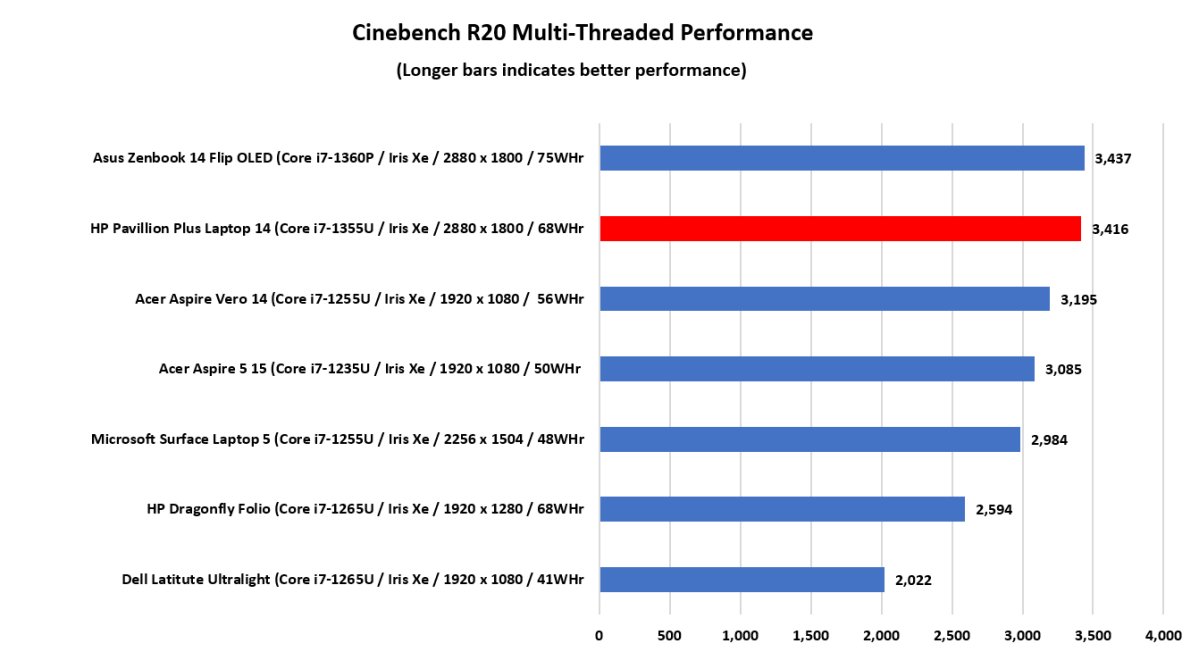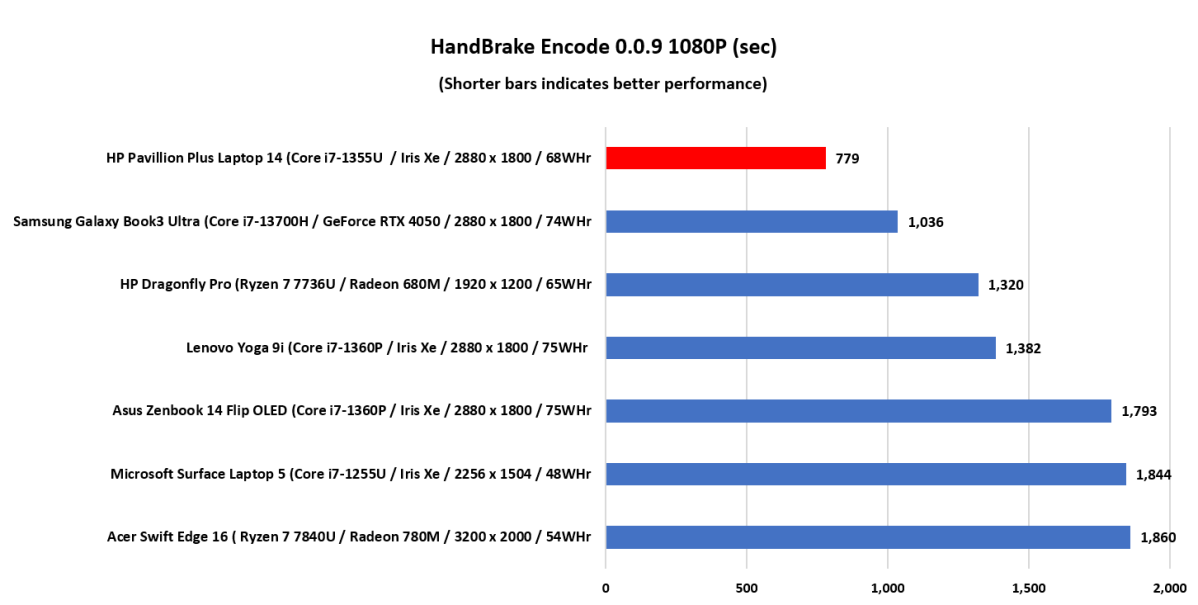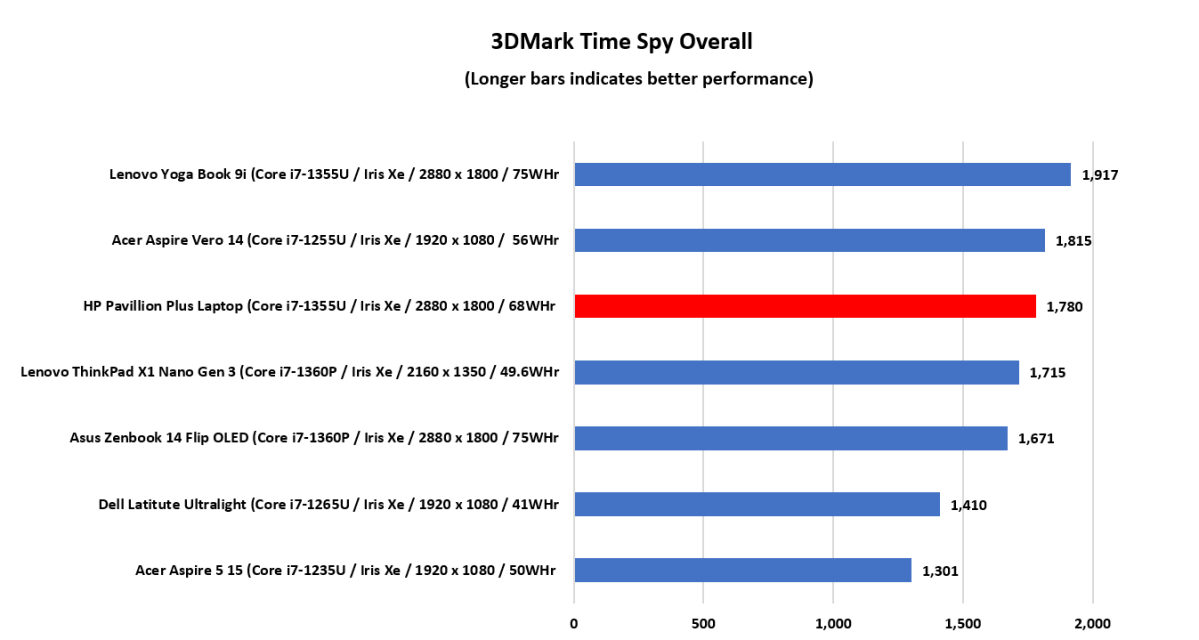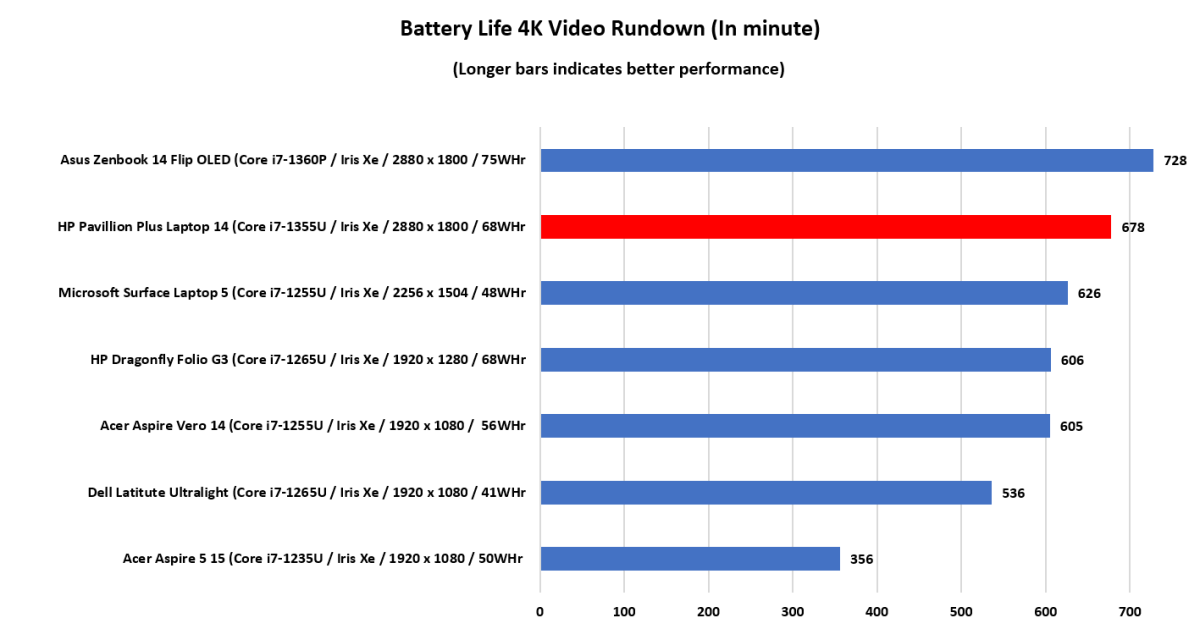HP Pavilion Plus Laptop 14 review: A zippy and affordable OLED laptop
 At a glanceExpert's Rating
Pros
At a glanceExpert's Rating
Pros- Excellent CPU performance for an Ultrabook
- The 2.8K OLED display is large and gorgeous
- A long battery life will run all day
- The lid feels plastic and can flex with pressure
- Downward facing speakers lack a strong bass presence
- The keys are loud and don’t rebound enough
The mainstream HP Pavilion Plus Laptop 14 gets the job done with its zippy 13th generation Intel CPU, gorgeous and generously framed 2.8K OLED display and a battery life that can run all day. It also won’t break the bank.
Price When Reviewed828.99
Best Prices Today: HP Pavilion Plus Laptop 14 Retailer Price $1178.99
View Deal
Price comparison from over 24,000 stores worldwide
Product
Price
Price comparison from Backmarket
$1178.99
View Deal
Price comparison from over 24,000 stores worldwide
Product
Price
Price comparison from Backmarket
HP’s Pavilion laptops present as the epitome of mainstream all-rounder laptops–equally primed for work as they are for light entertainment, they also don’t cost an arm and a leg. Indeed, HP’s newest Pavilion Plus Laptop 14 fits that bill entirely, with an upgraded Intel 13th Generation chip and a gorgeous OLED display. It’s even ideally priced to go forth and fill workplaces and living rooms everywhere.
That said, this newest model does something even better than its forebear. It has a longer battery life. For me, this simple upgrade ushers in a new era for the Pavilion brand, elevating it up a spot to nearer the more premium brands in HP’s lineup. Read on to learn more.
Looking for more options? Check out PCWorld’s roundup of the best laptops available right now.
HP Pavilion Plus 14: SpecificationsThe HP Pavilion Plus Laptop 14 comes in Intel Core i5-1335U or Intel Core i7-1355U flavors, both of which feature Intel Iris Xe graphics support. The laptop can be configured with one of three display options–either (1920x1200p) or (2560x1600p) IPS panels or, in my view, the cream of the crop, a (2880x1800p) OLED panel. The full specifications of my review unit are as follows:
- CPU: Intel i7-1355U
- RAM: 16GB DDR5 / 5200MHz
- Graphics: Intel Iris Xe
- Display: 14-inch, 2.8K (2880 x 1800), OLED, 120Hz refresh rate, 100% DCI-P3 color gamut, non-touch sensitive
- Storage: 512GB PCIe Gen 4 NVMe SSD
- Webcam: HP Wide Vision 5MP IR camera
- Connectivity: Thunderbolt 4, USB-C 3.2 Gen 2, USB-A 3.2 Gen 1, USB-A 3.2 Gen 2, HDMI 2.1, 3.5mm combo jack
- Networking: Wi-Fi 6E, Bluetooth 5.3
- Battery capacity: 68WHrs
- Dimensions: 12.36 x 8.94 x 0.68 inches
- Weight: 3.19 lbs (1.45kg)
- Cost: Base $1178.99 (currently $828.99) at HP
This $1,178.99 configuration feels about right where it should be from a cost perspective, but if you dial down the specs to an Intel i5-1355U CPU and 1920 x1200p IPS display, an entry level Pavilion Plus Laptop 14 costs just $828.99. When you consider what you’re getting for your money, that seems like very good value.
That’s not to say you won’t find that value elsewhere. You can currently buy an Asus Zenbook 14 Flip OLED, which comes with a slightly more powerful Intel i5-1340P processor for just $999. However, it’s a little chunkier and heavier than the Pavilion Plus.
A lighter, more ultra-portable option can be found in the Acer Swift 3 OLED. You can currently pick up a model with an Intel i7-12700H and Iris Xe graphics for $1,199.99 at Best Buy.
HP Pavilion Plus 14: Design and buildHaving spent my first afternoon with the Pavilion Plus Laptop 14, it became immediately clear where this laptop fits into HP’s lineup–that is, a little closer to the HP Envy and HP Spectre Series than previous Pavilions do. In fact, it’s really going to steal away some of the more sophisticated and discerning buyers from the latter brands.
Yes folks, the Pavilion Plus 14 exudes that ultra-portable swank that you’d usually have to drop upwards of $2,000 for, the kind that makes you want to just flip it and do some spread sheeting just for the joy of it.
What I like most about it is the clear-cut angles that taper down at the edges for a crisp uniform close. I also really like the color options–there being three tasteful ones to choose from. There’s the more personalized-looking Tranquil Pink and Moonlight Blue hues, or else a more productivity-friendly Natural Silver color also looks aplomb. All three colors are quite subtle, however, and can easily blend into any office environment.

The HP Pavilion Plus Laptop 14 comes in three attractive colors: Blue, Pink and Silver. Shown here: Midnight Blue
Dominic Bayley / IDG
The Pavilion Plus Laptop 14 spans a generous 12.3 x 8.94 x 0.68 inches in size, which makes it almost the same size as both the 14-inch Lenovo IdeaPad Slim 7 Carbon and the 14-inch Asus Vivobook S14 Flip OLED, the main difference being the thickness. The Vivobook is chunkier measuring 0.70 of an inch thick, the Slim 7 Carbon, on the other hand, is slightly thinner, measuring a mere 0.6 of an inch thick.
That’s with the lid shut. Opening the lid reveals the laptop’s splendid display, which is framed up in a glorious 16:10 aspect ratio. It provides a much more generous viewing space than the now dated-looking 16:9 aspect ratio and gives you the impression that you’re looking at a 15-inch display.
The Pavilion Plus Laptop 14 also hits a home run for being an ultraportable. At 3.3 pounds, it isn’t as lightweight as say, the 2.46 pound Lenovo X1 Carbon Gen 11, but it’s still light enough to pick up and hold in one hand.
When it comes to the build quality, it inspires both confidence and caution. The lid which is comprised mainly of plastic does flex a little when enough force is applied to it. On the other hand, the base of the chassis is comprised mainly of metal and should withstand a fair amount of battering.
HP Pavilion Plus 14: Keyboard and trackpadThere’s lots of room to stretch out on the laptop’s full-sized keyboard. It has large spaces to rest your arms either side of the trackpad. The keyboard is also nicely backlit with a white light that’s subtle, without being distractingly glary.
The key spacing is also generous, but the keys sound thwacky and loud and are unfortunately lacking the kind of rebound that I like for long writing stints. The trackpad is also generous in size and feels smooth and comfortable. But it’s also quite loud. It made a hollow sound when I clicked it. Still, it was responsive and accurate, allowing me to glide my fingers around the OLED display with ease and precision.

Dominic Bayley / IDG
HP Pavilion Plus 14: Connectivity and audioThe HP Pavilion Plus Laptop 14’s I/O offering is quite simple, but there’s enough there to effectively use it as a mobile workstation. It has a pair of USB-C ports and a pair of USB-A ports as well as an HDMI port and a 3.5mm combo jack.
I did find myself at times wishing it had an SD card reader, which would have made it a little easier for editing images straight from my DSLR, but the assortment still covered most of my needs–enough to comfortably run a mouse, external keyboard, and two external displays.
One of the USB-C ports is the really useful Thunderbolt 4 kind, which bestows the quick file transfer speed of up to 40Gb/s – I was well pleased by how fast it allowed me to load on all my usual benchmarking programs which can usually take up to half an hour.
The laptop’s audio comes courtesy of two downwards facing Bang and Olufson speakers located at the front of the chassis. They produce a nice clear treble and mid-range sound that would have been even clearer still had they been orientated in an upward facing direction. Their bass coverage is a little underwhelming, too. Bass notes can sound like just taps sometimes rather booms.
Still, for a fuller soundscape, I simply needed to plug in a surround sound headset since my OLED model supported DTS:X Ultra technology. This brought a dimensionality to the audio that really livened up videos.
HP Pavilion Plus 14: Display and webcamThere’s no denying that the Pavilion Plus’s gorgeous 2.8K resolution OLED display is the gem in its crown that will seal the deal for many potential buyers. Having tried a lot of OLED displays in laptops, I was really impressed by the rich hues in the 100 percent DCI-P3 color panel, which made even the most rudimentary work a vibrant and colorful experience.
The panel is also remarkably smooth thanks to its 48-120Hz variable refresh rate. If you’re unfamiliar with how that works, the laptop simply scales the rate to meet the needs of the kind of application you’re using. The Pavilion Plus also supports standard and HDR modes and both are reasonably bright. I measured 398 nits in standard mode and 456 nits maximum brightness in HDR mode and, just for the record, I could quite easily see details on the display in the well-lit parts of my living room.
Mentioned in this article… Asus Zenbook 14 Flip OLED
 Read our review
Price When Reviewed:
1199.99
Best Prices Today:
$999.99 at Asus |
Not Available at Amazon
Read our review
Price When Reviewed:
1199.99
Best Prices Today:
$999.99 at Asus |
Not Available at Amazon
HP also deserves credit for incorporating technologies that make the screen a little easier on your eyes like anti-glare and Low Blue Light. They might not be apparent all the time, but if you happen to pull an 11 hour working day, your eyes will thank their lucky stars for these extras.
The Pavilion Plus’s 5MP IR webcam is of a decent quality and it produces well-lit clear pictures most of the time. It presented my visage in natural-looking tones in work meetings and its 88 percent field of view ensured the images didn’t look unnaturally squashed or stretched.
HP Pavilion Plus 14: PerformanceIntel’s 13th Generation U Series CPUs are ideally suited to slim lightweight laptops where they deliver a power and efficiency profile that can meet the demands of mobile workers. The Pavilion’s Intel i7-1355U is the second most powerful CPU in this Series, occupying a rung on the ladder just below the Intel i7-1365U.
If we zoom in close on the i7-1355U, we see it sports 10 cores consisting of eight Efficient cores and two Performance cores. That’s a total of 12 threads. Despite the relatively modest core count, this CPU can muster a maximum turbo speed of up to 5GHz, which is impressive for a non-gaming laptop.
We tested the CPU performance using PCWorld benchmarks and Maxon’s Cinebench R20 Multi-Threaded benchmark, which flexes all of the cores of a laptop’s CPU. The i7-1355U proved it had enough grunt to handle heavy productivity tasks. It may be lightweight to lift up, but the laptop’s score of 3,416 means it can confidently tackle heavy jobs like video editing or encoding.

Dominic Bayley / IDG
This result was qualified by our next test, the PCMark 10 benchmark, which provides a snapshot of how our laptop is likely to perform in a range of common office tasks. An overall performance score of 5,446 placed the Pavilion Plus Laptop 14 just behind the Asus Zenbook 14 Flip OLED.
The results of the Handbrake test also bide well for the laptop’s CPU performance. Here, the Pavilion Plus finished encoding a 30GB MKV file to MP4 in just 779 seconds. This result proves the Pavilion Plus can effectively control its thermals to power on through high CPU-loads and finish tasks quickly.

Dominic Bayley / IDG
As for graphics performance, the HP Pavilion Plus Laptop 14 placed third in 3DMark’s Time Spy benchmark.

Dominic Bayley / IDG
This is a pretty clear-cut result that proves the laptop’s Intel Iris Xe graphics performance is about where it should be for performing light graphics-based tasks. Sure, you’re not going to get super quick frame rates when rendering 3D graphics like you would with most gaming laptops, but for lighter graphical tasks like rendering simple 3D animations, the Pavilion Plus should perform admirably.
HP Pavilion Plus 14: Battery lifeI keep a charger at home and another one at work for my Dell Vostro laptop, which is sometimes the only way I can get though a full day. That obsessiveness, I’m happy to report, is entirely unnecessary for the Pavilion Plus Laptop 14, which lasted a good five hours more than my Vostro.
To be precise, I recorded 11 hours and 18 minutes on PCWorld’s battery test, which loops a 4K Hollywood video on repeat until the laptop switches itself to standby mode. Among the comparisons, that time was only bettered by the Asus Zenbook 14 Flip OLED, which had 50 minutes more endurance.

Dominic Bayley / IDG
Based on that result, we can say the Pavilion Plus’s 68Whr battery is a great performer when the laptop is tasked with light jobs like watching videos or running simple apps.
If you want to do intermittent heavier work like editing videos or encoding files, you’re likely to get a lot less battery life than what we got here. But depending on the task you’re doing, it’s entirely possible the Pavilion Plus could still last to the end of a working day without needing to be recharged.
HP Pavilion Plus 14: Is it worth buying?It’s rare to find a laptop at this price that gets three of the most important things right: performance, battery life, and a gorgeous 2.8K OLED display. The HP Pavilion Plus Laptop 14 does just that and does it well. In my book, this trifecta of wins makes it a stellar productivity and light entertainment laptop that won’t break the bank.
Budget Laptops, Laptops